Chao Yang
Renal Division, Department of Medicine, Peking University First Hospital, Beijing, China, Center for Digital Health and Artificial Intelligence, Peking University First Hospital, Beijing, China
EGM: Efficiently Learning General Motion Tracking Policy for High Dynamic Humanoid Whole-Body Control
Dec 22, 2025Abstract:Learning a general motion tracking policy from human motions shows great potential for versatile humanoid whole-body control. Conventional approaches are not only inefficient in data utilization and training processes but also exhibit limited performance when tracking highly dynamic motions. To address these challenges, we propose EGM, a framework that enables efficient learning of a general motion tracking policy. EGM integrates four core designs. Firstly, we introduce a Bin-based Cross-motion Curriculum Adaptive Sampling strategy to dynamically orchestrate the sampling probabilities based on tracking error of each motion bin, eficiently balancing the training process across motions with varying dificulty and durations. The sampled data is then processed by our proposed Composite Decoupled Mixture-of-Experts (CDMoE) architecture, which efficiently enhances the ability to track motions from different distributions by grouping experts separately for upper and lower body and decoupling orthogonal experts from shared experts to separately handle dedicated features and general features. Central to our approach is a key insight we identified: for training a general motion tracking policy, data quality and diversity are paramount. Building on these designs, we develop a three-stage curriculum training flow to progressively enhance the policy's robustness against disturbances. Despite training on only 4.08 hours of data, EGM generalized robustly across 49.25 hours of test motions, outperforming baselines on both routine and highly dynamic tasks.
MCP-SafetyBench: A Benchmark for Safety Evaluation of Large Language Models with Real-World MCP Servers
Dec 17, 2025Abstract:Large language models (LLMs) are evolving into agentic systems that reason, plan, and operate external tools. The Model Context Protocol (MCP) is a key enabler of this transition, offering a standardized interface for connecting LLMs with heterogeneous tools and services. Yet MCP's openness and multi-server workflows introduce new safety risks that existing benchmarks fail to capture, as they focus on isolated attacks or lack real-world coverage. We present MCP-SafetyBench, a comprehensive benchmark built on real MCP servers that supports realistic multi-turn evaluation across five domains: browser automation, financial analysis, location navigation, repository management, and web search. It incorporates a unified taxonomy of 20 MCP attack types spanning server, host, and user sides, and includes tasks requiring multi-step reasoning and cross-server coordination under uncertainty. Using MCP-SafetyBench, we systematically evaluate leading open- and closed-source LLMs, revealing large disparities in safety performance and escalating vulnerabilities as task horizons and server interactions grow. Our results highlight the urgent need for stronger defenses and establish MCP-SafetyBench as a foundation for diagnosing and mitigating safety risks in real-world MCP deployments.
SilverTorch: A Unified Model-based System to Democratize Large-Scale Recommendation on GPUs
Nov 18, 2025Abstract:Serving deep learning based recommendation models (DLRM) at scale is challenging. Existing systems rely on CPU-based ANN indexing and filtering services, suffering from non-negligible costs and forgoing joint optimization opportunities. Such inefficiency makes them difficult to support more complex model architectures, such as learned similarities and multi-task retrieval. In this paper, we propose SilverTorch, a model-based system for serving recommendation models on GPUs. SilverTorch unifies model serving by replacing standalone indexing and filtering services with layers of served models. We propose a Bloom index algorithm on GPUs for feature filtering and a tensor-native fused Int8 ANN kernel on GPUs for nearest neighbor search. We further co-design the ANN search index and filtering index to reduce GPU memory utilization and eliminate unnecessary computation. Benefit from SilverTorch's serving paradigm, we introduce a OverArch scoring layer and a Value Model to aggregate results across multi-tasks. These advancements improve the accuracy for retrieval and enable future studies for serving more complex models. For ranking, SilverTorch's design accelerates item embedding calculation by caching the pre-calculated embeddings inside the serving model. Our evaluation on the industry-scale datasets show that SilverTorch achieves up to 5.6x lower latency and 23.7x higher throughput compared to the state-of-the-art approaches. We also demonstrate that SilverTorch's solution is 13.35x more cost-efficient than CPU-based solution while improving accuracy via serving more complex models. SilverTorch serves over hundreds of models online across major products and recommends contents for billions of daily active users.
HDW-SR: High-Frequency Guided Diffusion Model based on Wavelet Decomposition for Image Super-Resolution
Nov 17, 2025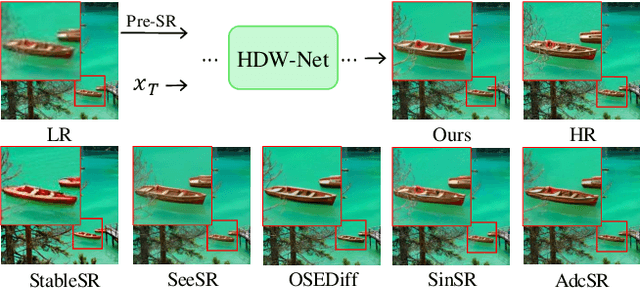
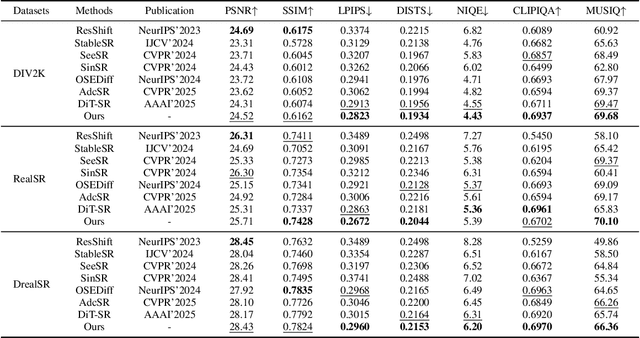
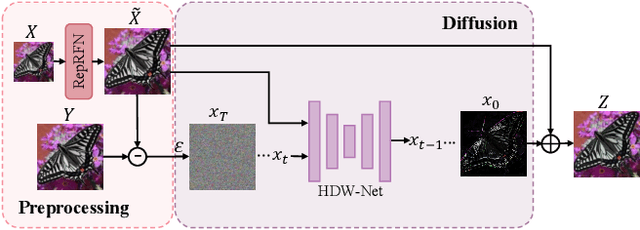

Abstract:Diffusion-based methods have shown great promise in single image super-resolution (SISR); however, existing approaches often produce blurred fine details due to insufficient guidance in the high-frequency domain. To address this issue, we propose a High-Frequency Guided Diffusion Network based on Wavelet Decomposition (HDW-SR), which replaces the conventional U-Net backbone in diffusion frameworks. Specifically, we perform diffusion only on the residual map, allowing the network to focus more effectively on high-frequency information restoration. We then introduce wavelet-based downsampling in place of standard CNN downsampling to achieve multi-scale frequency decomposition, enabling sparse cross-attention between the high-frequency subbands of the pre-super-resolved image and the low-frequency subbands of the diffused image for explicit high-frequency guidance. Moreover, a Dynamic Thresholding Block (DTB) is designed to refine high-frequency selection during the sparse attention process. During upsampling, the invertibility of the wavelet transform ensures low-loss feature reconstruction. Experiments on both synthetic and real-world datasets demonstrate that HDW-SR achieves competitive super-resolution performance, excelling particularly in recovering fine-grained image details. The code will be available after acceptance.
Online time series prediction using feature adjustment
Sep 04, 2025Abstract:Time series forecasting is of significant importance across various domains. However, it faces significant challenges due to distribution shift. This issue becomes particularly pronounced in online deployment scenarios where data arrives sequentially, requiring models to adapt continually to evolving patterns. Current time series online learning methods focus on two main aspects: selecting suitable parameters to update (e.g., final layer weights or adapter modules) and devising suitable update strategies (e.g., using recent batches, replay buffers, or averaged gradients). We challenge the conventional parameter selection approach, proposing that distribution shifts stem from changes in underlying latent factors influencing the data. Consequently, updating the feature representations of these latent factors may be more effective. To address the critical problem of delayed feedback in multi-step forecasting (where true values arrive much later than predictions), we introduce ADAPT-Z (Automatic Delta Adjustment via Persistent Tracking in Z-space). ADAPT-Z utilizes an adapter module that leverages current feature representations combined with historical gradient information to enable robust parameter updates despite the delay. Extensive experiments demonstrate that our method consistently outperforms standard base models without adaptation and surpasses state-of-the-art online learning approaches across multiple datasets. The code is available at https://github.com/xiannanhuang/ADAPT-Z.
SafeWork-R1: Coevolving Safety and Intelligence under the AI-45$^{\circ}$ Law
Jul 24, 2025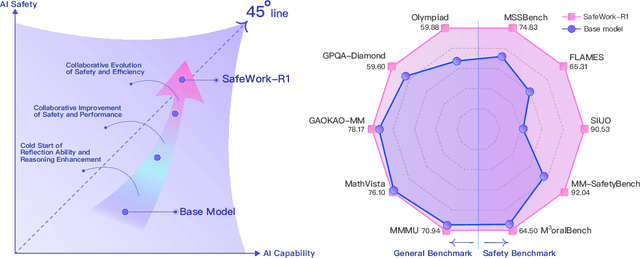
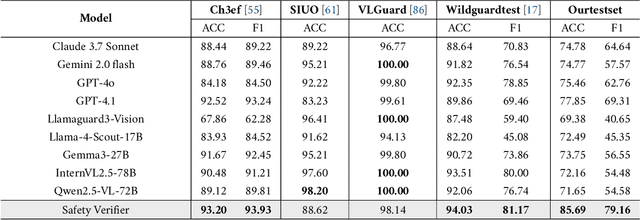
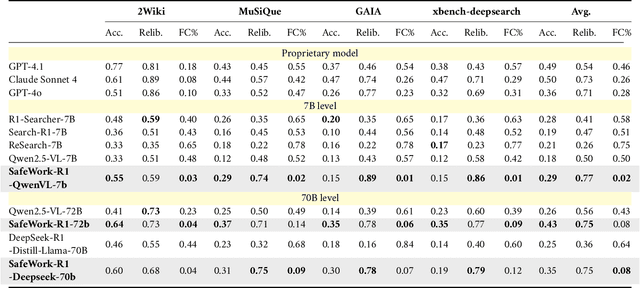

Abstract:We introduce SafeWork-R1, a cutting-edge multimodal reasoning model that demonstrates the coevolution of capabilities and safety. It is developed by our proposed SafeLadder framework, which incorporates large-scale, progressive, safety-oriented reinforcement learning post-training, supported by a suite of multi-principled verifiers. Unlike previous alignment methods such as RLHF that simply learn human preferences, SafeLadder enables SafeWork-R1 to develop intrinsic safety reasoning and self-reflection abilities, giving rise to safety `aha' moments. Notably, SafeWork-R1 achieves an average improvement of $46.54\%$ over its base model Qwen2.5-VL-72B on safety-related benchmarks without compromising general capabilities, and delivers state-of-the-art safety performance compared to leading proprietary models such as GPT-4.1 and Claude Opus 4. To further bolster its reliability, we implement two distinct inference-time intervention methods and a deliberative search mechanism, enforcing step-level verification. Finally, we further develop SafeWork-R1-InternVL3-78B, SafeWork-R1-DeepSeek-70B, and SafeWork-R1-Qwen2.5VL-7B. All resulting models demonstrate that safety and capability can co-evolve synergistically, highlighting the generalizability of our framework in building robust, reliable, and trustworthy general-purpose AI.
Listwise Preference Alignment Optimization for Tail Item Recommendation
Jul 03, 2025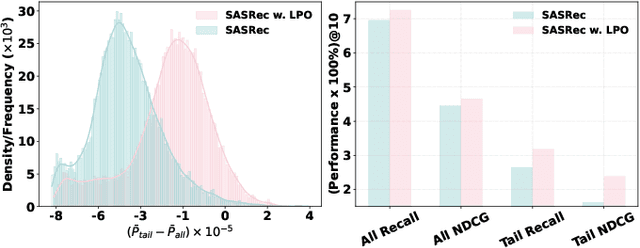

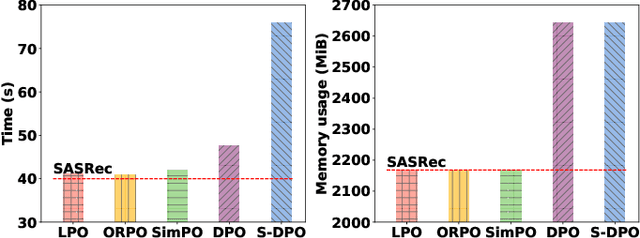
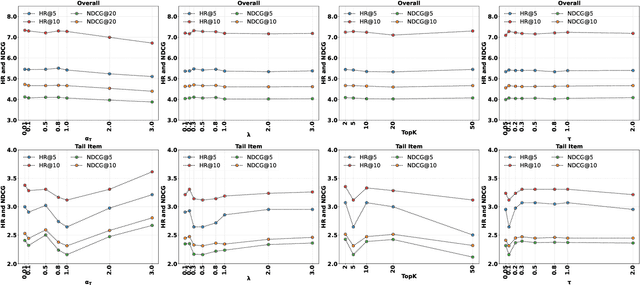
Abstract:Preference alignment has achieved greater success on Large Language Models (LLMs) and drawn broad interest in recommendation research. Existing preference alignment methods for recommendation either require explicit reward modeling or only support pairwise preference comparison. The former directly increases substantial computational costs, while the latter hinders training efficiency on negative samples. Moreover, no existing effort has explored preference alignment solutions for tail-item recommendation. To bridge the above gaps, we propose LPO4Rec, which extends the Bradley-Terry model from pairwise comparison to listwise comparison, to improve the efficiency of model training. Specifically, we derive a closed form optimal policy to enable more efficient and effective training without explicit reward modeling. We also present an adaptive negative sampling and reweighting strategy to prioritize tail items during optimization and enhance performance in tail-item recommendations. Besides, we theoretically prove that optimizing the listwise preference optimization (LPO) loss is equivalent to maximizing the upper bound of the optimal reward. Our experiments on three public datasets show that our method outperforms 10 baselines by a large margin, achieving up to 50% performance improvement while reducing 17.9% GPU memory usage when compared with direct preference optimization (DPO) in tail-item recommendation. Our code is available at https://github.com/Yuhanleeee/LPO4Rec.
Using Vision Language Models to Detect Students' Academic Emotion through Facial Expressions
Jun 12, 2025Abstract:Students' academic emotions significantly influence their social behavior and learning performance. Traditional approaches to automatically and accurately analyze these emotions have predominantly relied on supervised machine learning algorithms. However, these models often struggle to generalize across different contexts, necessitating repeated cycles of data collection, annotation, and training. The emergence of Vision-Language Models (VLMs) offers a promising alternative, enabling generalization across visual recognition tasks through zero-shot prompting without requiring fine-tuning. This study investigates the potential of VLMs to analyze students' academic emotions via facial expressions in an online learning environment. We employed two VLMs, Llama-3.2-11B-Vision-Instruct and Qwen2.5-VL-7B-Instruct, to analyze 5,000 images depicting confused, distracted, happy, neutral, and tired expressions using zero-shot prompting. Preliminary results indicate that both models demonstrate moderate performance in academic facial expression recognition, with Qwen2.5-VL-7B-Instruct outperforming Llama-3.2-11B-Vision-Instruct. Notably, both models excel in identifying students' happy emotions but fail to detect distracted behavior. Additionally, Qwen2.5-VL-7B-Instruct exhibits relatively high performance in recognizing students' confused expressions, highlighting its potential for practical applications in identifying content that causes student confusion.
SafeCoT: Improving VLM Safety with Minimal Reasoning
Jun 11, 2025Abstract:Ensuring safe and appropriate responses from vision-language models (VLMs) remains a critical challenge, particularly in high-risk or ambiguous scenarios. We introduce SafeCoT, a lightweight, interpretable framework that leverages rule-based chain-of-thought (CoT) supervision to improve refusal behavior in VLMs. Unlike prior methods that rely on large-scale safety annotations or complex modeling, SafeCoT uses minimal supervision to help models reason about safety risks and make context-aware refusals. Experiments across multiple benchmarks show that SafeCoT significantly reduces overrefusal and enhances generalization, even with limited training data. Our approach offers a scalable solution for aligning VLMs with safety-critical objectives.
RePO: Replay-Enhanced Policy Optimization
Jun 11, 2025Abstract:Reinforcement learning (RL) is vital for optimizing large language models (LLMs). Recent Group Relative Policy Optimization (GRPO) estimates advantages using multiple on-policy outputs per prompt, leading to high computational costs and low data efficiency. To address this, we introduce Replay-Enhanced Policy Optimization (RePO), which leverages diverse replay strategies to retrieve off-policy samples from a replay buffer, allowing policy optimization based on a broader and more diverse set of samples for each prompt. Experiments on five LLMs across seven mathematical reasoning benchmarks demonstrate that RePO achieves absolute average performance gains of $18.4$ and $4.1$ points for Qwen2.5-Math-1.5B and Qwen3-1.7B, respectively, compared to GRPO. Further analysis indicates that RePO increases computational cost by $15\%$ while raising the number of effective optimization steps by $48\%$ for Qwen3-1.7B, with both on-policy and off-policy sample numbers set to $8$. The repository can be accessed at https://github.com/SihengLi99/RePO.
 Add to Chrome
Add to Chrome Add to Firefox
Add to Firefox Add to Edge
Add to Edge